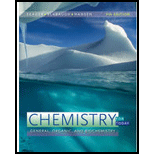
Concept explainers
(a)
Interpretation:
The structural formula for the organic product formed by the reaction of given compound with Tollens’s reagent is to be drawn.
Concept introduction:
Tollens test is a laboratory test which is used to identify an
(b)
Interpretation:
The structural formula for the organic product formed by the reaction of given compound with Tollens’s reagent is to be drawn.
Concept introduction:
Tollens test is a laboratory test which is used to identify an aldehyde and a ketone. It is also called as silver mirror test. In this test, Tollens reagent is used for the oxidation of aldehyde, whereas ketone does not give this test. Thus, the reaction of aldehyde with Tollens reagent gives a positive Tollens test.
(c)
Interpretation:
The structural formula for the organic product formed by the reaction of given compound with Tollens’s reagent is to be drawn.
Concept introduction:
Tollens test is a laboratory test which is used to identify an aldehyde and a ketone. It is also called as silver mirror test. In this test, Tollens reagent is used for the oxidation of aldehyde, whereas ketone does not give this test. Thus, the reaction of aldehyde with Tollens reagent gives a positive Tollens test.
(d)
Interpretation:
The structural formula for the organic product formed by the reaction of given compound with Tollens’s reagent is to be drawn.
Concept introduction:
Tollens test is a laboratory test which is used to identify an aldehyde and a ketone. It is also called as silver mirror test. In this test, Tollens reagent is used for the oxidation of aldehyde, whereas ketone does not give this test. Thus, the reaction of aldehyde with Tollens reagent gives a positive Tollens test.
(e)
Interpretation:
The structural formula for the organic product formed by the reaction of given compound with Tollens’s reagent is to be drawn.
Concept introduction:
Tollens test is a laboratory test which is used to identify an aldehyde and a ketone. It is also called as silver mirror test. In this test, Tollens reagent is used for the oxidation of aldehyde, whereas ketone does not give this test. Thus, the reaction of aldehyde with Tollens reagent gives a positive Tollens test.
Trending nowThis is a popular solution!

Chapter 14 Solutions
Study Guide with Student Solutions Manual for Seager/Slabaugh/Hansen's Chemistry for Today: General, Organic, and Biochemistry, 9th Edition
- Calculate the pH and the pOH of each of the following solutions at 25 °C for which the substances ionize completely: (a) 0.200 M HClarrow_forwardCalculate the pH and the pOH of each of the following solutions at 25 °C for which the substances ionize completely: (a) 0.000259 M HClO4arrow_forwardWhat is the pH of a 1.0 L buffer made with 0.300 mol of HF (Ka = 6.8 × 10⁻⁴) and 0.200 mol of NaF to which 0.160 mol of NaOH were added?arrow_forward
- Determine if the following salt is neutral, acidic or basic. If acidic or basic, write the appropriate equilibrium equation for the acid or base that exists when the salt is dissolved in aqueous solution. If neutral, simply write only NR. Be sure to include the proper phases for all species within the reaction. NaN₃arrow_forwardCan I please get help with this?arrow_forwardCan I please get help with this?arrow_forward
- Use the Henderson-Hasselbalch equation to calculate pH of a buffer containing 0.050M benzoic acidand 0.150M sodium benzoate. The Ka of benzoic acid is 6.5 x 10-5arrow_forwardA. Draw the structure of each of the following alcohols. Then draw and name the product you would expect to produce by the oxidation of each. a. 4-Methyl-2-heptanol b. 3,4-Dimethyl-1-pentanol c. 4-Ethyl-2-heptanol d. 5,7-Dichloro-3-heptanolarrow_forwardWhat is the pH of a 1.0 L buffer made with 0.300 mol of HF (Ka = 6.8 × 10⁻⁴) and 0.200 mol of NaF to which 0.160 mol of NaOH were added?arrow_forward
- Can I please get help with this.arrow_forwardDetermine if the following salt is neutral, acidic or basic. If acidic or basic, write the appropriate equilibrium equation for the acid or base that exists when the salt is dissolved in aqueous solution. If neutral, simply write only NR. Be sure to include the proper phases for all species within the reaction. N₂H₅ClO₄arrow_forwardPlease help me with identifying these.arrow_forward
 Chemistry & Chemical ReactivityChemistryISBN:9781337399074Author:John C. Kotz, Paul M. Treichel, John Townsend, David TreichelPublisher:Cengage Learning
Chemistry & Chemical ReactivityChemistryISBN:9781337399074Author:John C. Kotz, Paul M. Treichel, John Townsend, David TreichelPublisher:Cengage Learning Chemistry & Chemical ReactivityChemistryISBN:9781133949640Author:John C. Kotz, Paul M. Treichel, John Townsend, David TreichelPublisher:Cengage Learning
Chemistry & Chemical ReactivityChemistryISBN:9781133949640Author:John C. Kotz, Paul M. Treichel, John Townsend, David TreichelPublisher:Cengage Learning

